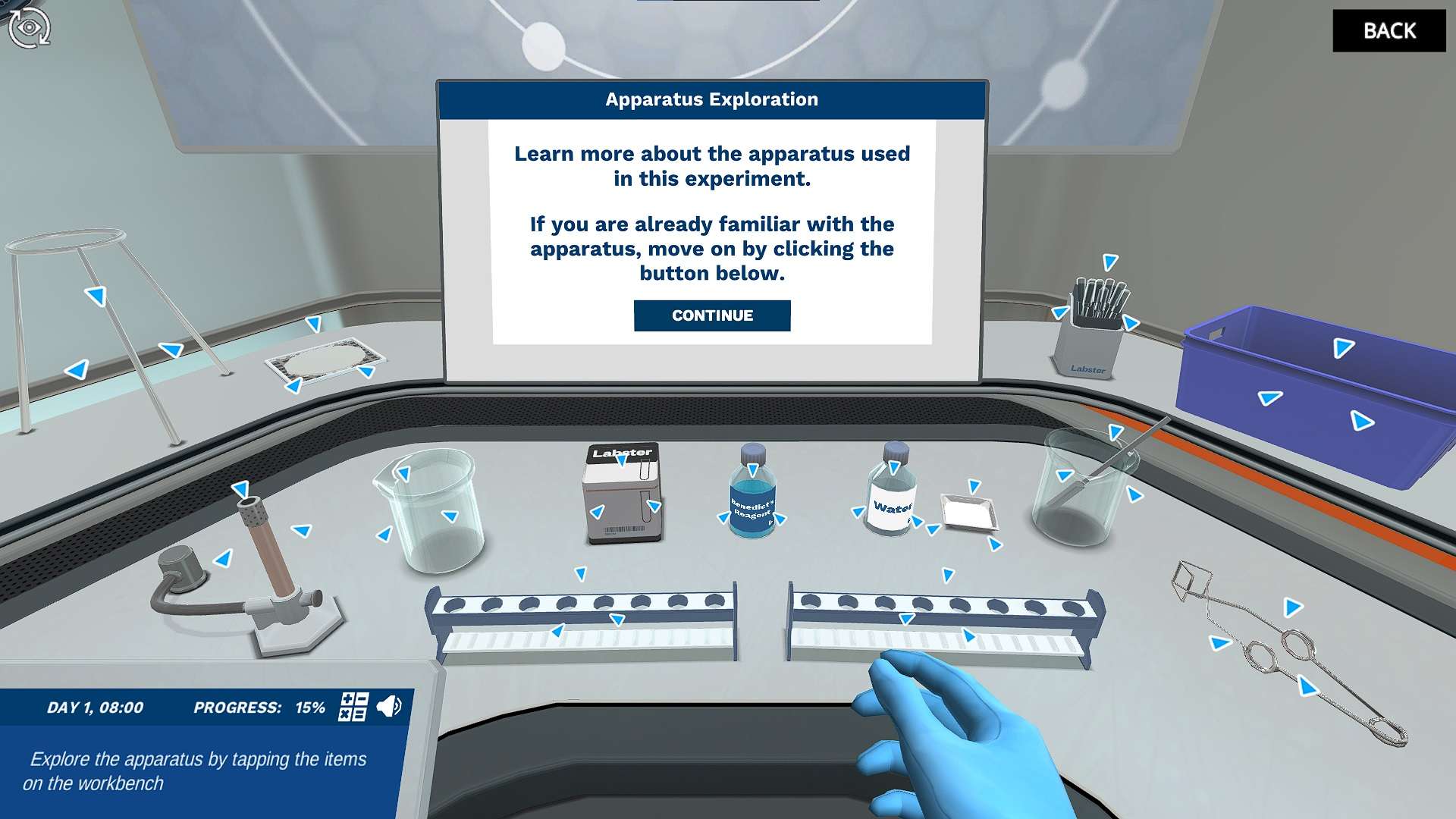Heading 1
Heading 2
Heading 3
Heading 4
Heading 5
Heading 6
Lorem ipsum dolor sit amet, consectetur adipiscing elit, sed do eiusmod tempor incididunt ut labore et dolore magna aliqua. Ut enim ad minim veniam, quis nostrud exercitation ullamco laboris nisi ut aliquip ex ea commodo consequat. Duis aute irure dolor in reprehenderit in voluptate velit esse cillum dolore eu fugiat nulla pariatur.
Block quote
Ordered list
- Item 1
- Item 2
- Item 3
Unordered list
- Item A
- Item B
- Item C
Bold text
Emphasis
Superscript
Subscript
About This Simulation
Learn how to perform Benedict’s test for reducing sugars on a variety of food samples. Predict which samples contain reducing sugars and find out how your predictions compare to your results!
Learning Objectives
- Process a food sample through Benedict’s test for reducing sugars
- Briefly describe the reaction mechanism that permits the detection of reducing sugars
- Interpret the results of Benedict's test
About This Simulation
Lab Techniques
- Reducing sugars
- Positive and negative controls
- Benedict's test
Related Standards
- HS-PS2-6
Learn More About This Simulation
Practice makes perfect! In this simulation you will learn how to perform Benedict’s test for reducing sugars on a variety of food samples. You will use your existing knowledge of food macromolecules to predict which samples contain reducing sugars. Dr. One will then guide you in processing the food samples through Benedict’s test. How will your predictions compare to your results?
Make a prediction
Start by getting familiar with the apparatus on your workbench and setting up the heated water bath. Now that you’re set up, use your existing knowledge to predict which food samples will contain reducing sugars. Don’t be afraid to make mistakes. Later you will compare your predictions to your results.
Perform Benedict’s test
Learn how to process food samples through Benedict’s test as if you were in a lab! With step by step guidance from Dr. One, you will process the food samples through Benedict’s test and generate some colorful results. Combine the theory of Benedict’s test with your observations to interpret your results and discover which food samples contain reducing sugars.
Results vs. Prediction
The final step is to compare your results to your predictions. Did your results match the predictions? Are there any results that are surprising?
For Science Programs Providing a Learning Advantage
Boost STEM Pass Rates
Boost Learning with Fun
75% of students show high engagement and improved grades with Labster
Discover Simulations That Match Your Syllabus
Easily bolster your learning objectives with relevant, interactive content
Place Students in the Shoes of Real Scientists
Practice a lab procedure or visualize theory through narrative-driven scenarios


FAQs
Find answers to frequently asked questions.
Heading 1
Heading 2
Heading 3
Heading 4
Heading 5
Heading 6
Lorem ipsum dolor sit amet, consectetur adipiscing elit, sed do eiusmod tempor incididunt ut labore et dolore magna aliqua. Ut enim ad minim veniam, quis nostrud exercitation ullamco laboris nisi ut aliquip ex ea commodo consequat. Duis aute irure dolor in reprehenderit in voluptate velit esse cillum dolore eu fugiat nulla pariatur.
Block quote
Ordered list
- Item 1
- Item 2
- Item 3
Unordered list
- Item A
- Item B
- Item C
Bold text
Emphasis
Superscript
Subscript
A Labster virtual lab is an interactive, multimedia assignment that students access right from their computers. Many Labster virtual labs prepare students for success in college by introducing foundational knowledge using multimedia visualizations that make it easier to understand complex concepts. Other Labster virtual labs prepare learners for careers in STEM labs by giving them realistic practice on lab techniques and procedures.
Labster’s virtual lab simulations are created by scientists and designed to maximize engagement and interactivity. Unlike watching a video or reading a textbook, Labster virtual labs are interactive. To make progress, students must think critically and solve a real-world problem. We believe that learning by doing makes STEM stick.
Yes, Labster is compatible with all major LMS (Learning Management Systems) including Blackboard, Canvas, D2L, Moodle, and many others. Students can access Labster like any other assignment. If your institution does not choose an LMS integration, students will log into Labster’s Course Manager once they have an account created. Your institution will decide which is the best access method.
Labster is available for purchase by instructors, faculty, and administrators at education institutions. Purchasing our starter package, Labster Explorer, can be done using a credit card if you are located in the USA, Canada, or Mexico. If you are outside of North America or are choosing a higher plan, please speak with a Labster sales representative. Compare plans.
Labster supports a wide range of STEM courses at the high school, college, and university level across fields in biology, chemistry, physics, and health sciences. You can identify topics for your courses by searching our Content Catalog.















